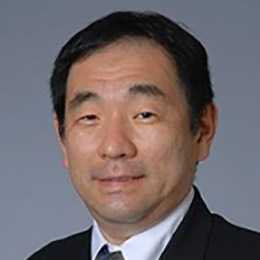Yuichiro Takagi, Ph.D.
Associate Professor, Associate Professor of Biochemistry and Molecular Biology

Associate Professor, Associate Professor of Biochemistry and Molecular Biology
The concept of the cell as a collection of multi-subunit protein complexes, molecular machines, is emerging as a cornerstone of modern biology. Class II gene transcription is a prime example for this concept. Eukaryotic transcription by RNA polymerase II is driven by series of molecular machines. Representative steps include modification of chromatin templates, gene-specific initiation, transcription elongation and termination. Deciphering structures of these molecular machines and their interactions at high resolution is vital to understand biology. Moreover, since mutations in various subunits of these complexes are associated with diseases such as cancer, studies of these complexes are of clinical importance as they might serve as the next generation of drug targets for treatments of many human diseases.
The focus of my laboratory is to investigate the structure and function of large multi-protein complexes in gene expression in eukaryotes. The preparations of many essential molecular machines can be a considerable challenge due to the low abundance and heterogeneity often associated with their extraction from native sources. Therefore, our approach takes advantage of our expertise to generate multi-protein complexes in recombinant forms for structural and functional studies by utilizing the advanced protein complex expression technologies (see refs 1-3). We have successfully applied our expertise to generate the recombinant Mediator Head module (7 subunits, 223 kDa), an essential sub-complex of Mediator of transcription regulation, in a large quantity, which led us to solve the Head structure first by cryo-EM (ref. 7) and eventually by X-ray crystallography (ref. 5) (see Figure 1) - Our crystal structure has revealed how this essential complex is built from its components combining stability as well as flexibility for transcription regulation, providing a platform for other transcription factors (ref. 5) (see Figure 1).
The current projects include (i) reconstitution and structure determination of the entire Mediator complex, which is composed of 21 subunits (see Figure 1), (ii) structure-guided functional studies of the mechanisms of Mediator, (iii) reconstitution of multi-protein complexes involved in gene expressions, and (iv) engineering of protein complex expression and purification technologies.
My laboratory has established expertise uniquely positions us to undertake structural and functional studies of molecular machines, aiming toward elucidation of mechanisms of regulation in eukaryotic gene expressions.
Protein-engineering and structural biology of molecular machineries in gene expression. More details...
1. Barford, D., Takagi, Y., Schultz, P., and Berger, I. (2013). Baculovirus expression: tackling the complexity challenge. Curr Opin Struct Biol. In press
2. Bieniossek, C., Imasaki, T., Takagi, Y., and Berger, I. (2012). MultiBac: expanding the research toolbox for multiprotein complexes. Trends in biochemical sciences 37, 49-57.
3. Trowitzsch, S., Palmberger, D., Fitzgerald, D., Takagi, Y., and Berger, I. (2012). MultiBac complexomics. Expert Rev Proteomics 9, 363-373.
4. Cai, G., Chaban, Y.L., Imasaki, T., Kovacs, J.A., Calero, G., Penczek, P.A., Takagi, Y., and Asturias, F.J. (2012). Interaction of the Mediator Head Module with RNA Polymerase II. Structure 20, 899-910.
5. Imasaki, T., Calero, G., Cai, G., Tsai, K.L., Yamada, K., Cardelli, F., Erdjument-Bromage, H., Tempst, P., Berger, I., Kornberg, G.L., Astruias, F.J., Kornberg, R.D., Takagi, Y. (2011). Architecture of the Mediator head module. Nature 475, 240-243.
6. Yu, X., Chen, M., Zhang, S., Yu, Z.H., Sun, J.P., Wang, L., Liu, S., Imasaki, T., Takagi, Y., and Zhang, Z.Y. (2011). Substrate specificity of lymphoid-specific tyrosine phosphatase (Lyp) and identification of Src kinase-associated protein of 55 kDa homolog (SKAP-HOM) as a Lyp substrate. The Journal of biological chemistry.
7. Cai, G., Imasaki, T., Yamada, K., Cardelli, F., Takagi, Y., and Asturias, F.J. (2010). Mediator head module structure and functional interactions. Nature structural & molecular biology 17, 273-279.
8. Cai, G., Imasaki, T., Takagi, Y., and Asturias, F.J. (2009). Mediator structural conservation and implications for the regulation mechanism. Structure 17, 559-567.
9. Toth-Petroczy, A., Oldfield, C.J., Simon, I., Takagi, Y., Dunker, A.K., Uversky, V.N., and Fuxreiter, M. (2008). Malleable machines in transcription regulation: the mediator complex. PLoS computational biology 4, e1000243.
10. Takagi, Y., Calero, G., Komori, H., Brown, J.A., Ehrensberger, A.H., Hudmon, A., Asturias, F., and Kornberg, R.D. (2006). Head module control of mediator interactions. Mol Cell23, 355-364.